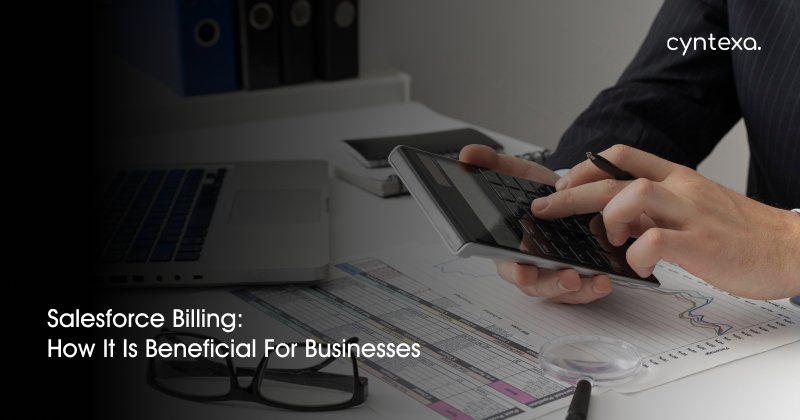Table of Contents
Are you still doing invoices manually? Is it hard for you to keep track of your billing? If yes, you’re in the right place. Many businesses still face these challenges. Performing manual tasks is time-consuming and overwhelming, which affects the business’s productivity.
However, with Salesforce billing, you get a streamlined billing process that boosts your business’s productivity and efficiency. This blog will teach you about Salesforce billing and its related characteristics.
Let’s get started!
What is Salesforce Billing?
It is a platform that automates your billing process, manages invoices, and transforms revenue processes. It is an add-on package that works with Salesforce CPQ. Once the sales rep finalizes the quote and places an order, Salesforce billing picks it up and handles the invoicing, payment, and revenue recognition.
Let’s understand this simply. Suppose you own a lemonade cart. When a customer comes, you write their order and how much they must pay. This is similar to creating an invoice.
Over time, as your customer base expands, manually writing everything down and serving them becomes hectic. And you need to hire someone to take orders and handle payments for you.
Similarly, Salesforce billing is like a helper. It automatically records all orders and tracks whether customers have paid for them. Furthermore, it counts how much money you have made.
Additionally, if you introduce new products in your business, Salesforce billing can handle that too. It also keeps track of everything you sell.
Key Features of Salesforce Billing

1. Invoicing
Salesforce billing is known for its automated invoicing feature. As soon as the sales representative finalizes the quote and places the order, Salesforce billing automatically picks it up and creates an invoice with all the relevant details.
The order details include the products or services ordered, their quantity, price, and whether additional taxes or discounts are calculated.
Moreover, Salesforce billing brings sales and finance together and is responsible for the smooth lead-to-payment cycle.
2. Payments
With Salesforce billing, you get a comprehensive system that manages customer payment information and passes it to the customer’s bank. You can also investigate skipped and unsettled invoices and ensure a follow-up.
Here are the various critical aspects of ‘Payments’ in Salesforce billing:
- Payment Object: This is a financial object that stores a payment event, including details like the payment amount, payment type, and the account to which the payment could be applied.
- Payment Creation: It allows three different ways to create a payment: through account receivables, through admins who can evaluate the posted invoices through scheduled payments, and lastly, through end consumers. They can enter the Salesforce payment billing center and pay invoices using their favourite payment methods.
- Payment Status: This checks the payment status of the invoices, once they are completed, the funds are applied to one or more invoices.
- Payment Methods: This stores the customers’ ACH and credit card information and the payment gateways used for accepting payments.
- Processing Payments: This is responsible for gathering the customer’s payment information and passing it to their bank.
3. Revenue Recognition
This feature of Salesforce billing manages and tracks the business’s revenue by selling its products and services. When you sell a product or service, you must record when and how you earn revenue. Salesforce helps you set rules for this.
For example, if you sell a one-year subscription, you might want to record monthly revenue for 12 months rather than all at once. Salesforce helps you schedule and keep track of these transactions. It also enables you to report your revenue accurately.
Benefits of Salesforce Billing

1. You Get Complete Visibility Into Transactions
Salesforce billing is like a ledger for your business. It includes every transaction in and out, and similarly, Salesforce billing records every transaction, including the payment status. With this, businesses get a clear picture of their revenue, be it daily, monthly, or annually. They can look into any unpaid invoices and follow up with customers accordingly.
2. Automated Invoice Creation Process
As we have already discussed, manual invoicing can be very time-consuming and prone to errors. However, with Salesforce billing, you can automate this process. This means that as soon as the order is placed, the system automatically generates the invoice, saving time and also ensuring accuracy in the process.
3. Flexible Payment Models
Different customers have different preferences, so they prefer different payment methods. Some might prefer one-time payments, while others might consider subscription-based payments. It would be confusing for a business to handle these for many customers.
Salesforce billing supports all kinds of payment models, giving customers the flexibility to choose what they want to use. This way, businesses can cater to a large audience without restricting themselves to a single payment model.
4. Dynamic Reports and Dashboards
Businesses need a solution to monitor their revenue, sales, purchases, and other aspects to make decisions for their business growth. Thus they can create reports and dashboards that give them a real-time view of their revenue data.
By getting this information, businesses can identify trends, spot opportunities, assess their strengths and weaknesses, and make data-driven decisions.
5. Notifies the Customers
When the customers are informed about their orders, payments and their status, this makes customers feel valued, ultimately contributing towards enhanced customer relationships.
Salesforce billing helps improve customer satisfaction and relationships by sending them timely notifications. These are sent through various channels, including emails, SMS or social media platforms. It keeps them updated about their orders, invoices and payments.
6. Seamless Integration with Other Systems
Salesforce billing is capable of seamlessly integrating with other systems that help businesses work efficiently. These systems include Enterprise Resource Planning (ERP), Customer Relationship Management (CRM) and Salesforce CPQ.
Let’s see how it’s done.
Salesforce CPQ and Salesforce Billing: Think of Salesforce CPQ (Configure, Price, Quote) as a salesperson and Salesforce Billing as a cashier. The salesperson (CPQ) helps the customer choose products, decide on custom configurations, and agree on the price. Once the deal is done, it’s handed over to the cashier (Billing) to generate an invoice and collect payment.
Salesforce Billing and ERP Systems: ERP systems are like the company’s accountant. They keep track of all the financial transactions and help in financial reporting. Salesforce Billing prepares the sales data in a way that the ERP system can understand and use. So, after the cashier (Billing) collects the payment, they pass the transaction details to the accountant (ERP) for record-keeping.
Salesforce Billing and CRM Systems: CRM systems are like the company’s customer service reps. They keep track of all interactions with customers. Salesforce Billing integrates with CRM systems to provide a complete view of the customer. So, if a service rep (CRM) needs to check if a customer has paid their bill, they can easily find that information from the cashier (Billing).
Salesforce Billing Pricing
Salesforce has not fixed any particular price for Salesforce billing. It might fluctuate based on what services you are rendering.
It comes in various editions, from the basic to the premium versions. Each of these versions has different features, and the cost upgrades as the version upgrades. Align with this, the cost also depends on how many users a business has. More the users, the more the cost.
Furthermore, the cost adds up if any add-on solutions or applications are rendered. Along with this, Salesforce offers different levels of support and guidance for your business, which come at different costs.
To get a clearer estimation, you can consult a Salesforce partner firm. They understand all your requirements and suggest the best solution possible.
Salesforce Billing Best Practices

Before you move further with implementing Salesforce billing into your business, you must look into its prerequisites.
Here are a few best practices you must follow for a safe and successful implementation.
1. Implementing Security Measures
It is very important to consider security measures in today’s tech-driven world. Many unauthorized parties are ready to attack data and misuse it for their demeaning benefits.
- Enable multi-factor authentication to add an extra layer of security to user logins.
- Use strong passwords and frequently update them.
- Enable role-based access control so that users can access only the relevant information.
- Set up alerts for false patterns like multiple failed login attempts, which could indicate a security breach.
2. Providing Training and Support for Users
The users require training to get their hands on with Salesforce Billing.
- To eliminate any kind of confusion, communicate clear training objectives to the users, including what they will learn, how they will learn, and how this learning will help them.
- Create a training plan and move forward accordingly. Minor changes could be entertained.
- Create a repository of training resources and materials you can refer to and share with the users.
- Incorporate learning into user’s work routines and support them.
3. Keeping Up with Updates and Enhancements
It is optimal to keep upgrading your Salesforce platform with the latest technologies and enhancements, as this introduces new features and enhanced capabilities into the existing features. Moreover, the latest security updates ensure protection from any new vulnerabilities and threats.
Keep on checking for updates and maintenance and apply patches promptly.
How Do You Get Started with Salesforce Billing?
Setting Up Salesforce Billing in Salesforce
- Ensure that Salesforce billing is enabled in your Salesforce instance.
- Install the Salesforce billing package from Salesforce AppExchange, which includes the necessary components for billing functionality.
- Allow required permissions to users who are working over the platform.
- Set up basic billing settings that are required to start with basic functionalities.
Configure Billing Processes and Workflows
- Start by creating various product records that you will offer to your customers. Then, specify the price against them. Use the structures defined in Salesforce billing.
- Set up billing contracts with details including the billing frequency, start and end dates, terms and conditions and more.
- Set up billing rules that define how the charges would be applied to an invoice. Charges related to discounts, taxes and more.
- Configure the revenue recognition rules based on your favourable time cycle.
- Set up automated invoice generation based on the rules and configurations above.
Now that we have learned about Salesforce billing and the benefits it offers, you might consider incorporating it into your business to experience seamless invoicing and payment processing. But what if you can get additional features and capabilities with it just by integrating it with an application called ChargeOn?
Let’s See How Does ChargeOn Help
- More Payment Gateways: ChargeOn helps you integrate the top 15 payment gateways with your Salesforce platform so that you can cater to a large audience, eliminating geographical differences.
- Automated Recurring Billing Feature: ChargeOn can help in Salesforce subscription management by automating the process if your business accepts subscription payments. With this, you save a sufficient amount of time along with timely payments.
- Tokenization: With this, you can accept payments in multiple currencies without worrying about monetary threats. It provides you and your customers with high-security measures that safeguard sensitive information. The information is converted into tokens, which are not visible to any other party.
- Payment Requesting Links: ChargeOn allows users to send payment links through various communication channels. This will enable you to investigate skipped payments and follow up on them, making transactions smoother and the process optimal.
Conclusion
In this detailed blog, we have discussed many things about salesforce billing and also described its features and benefits. However, Salesforce billing requires additional integration of other related services that diversify the tracing and managing process. To overcome this problem ChargeOn discovered it provides all the required services in a single place and seamlessly connects with your preferred payment gateway and salesforce













